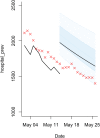Uncertainty quantification for epidemiological forecasts of COVID-19 through combinations of model predictions
- PMID: 35799481
- PMCID: PMC9272045
- DOI: 10.1177/09622802221109523
Uncertainty quantification for epidemiological forecasts of COVID-19 through combinations of model predictions
Abstract
Scientific advice to the UK government throughout the COVID-19 pandemic has been informed by ensembles of epidemiological models provided by members of the Scientific Pandemic Influenza group on Modelling. Among other applications, the model ensembles have been used to forecast daily incidence, deaths and hospitalizations. The models differ in approach (e.g. deterministic or agent-based) and in assumptions made about the disease and population. These differences capture genuine uncertainty in the understanding of disease dynamics and in the choice of simplifying assumptions underpinning the model. Although analyses of multi-model ensembles can be logistically challenging when time-frames are short, accounting for structural uncertainty can improve accuracy and reduce the risk of over-confidence in predictions. In this study, we compare the performance of various ensemble methods to combine short-term (14-day) COVID-19 forecasts within the context of the pandemic response. We address practical issues around the availability of model predictions and make some initial proposals to address the shortcomings of standard methods in this challenging situation.
Keywords: COVID-19; disease forecasting; model combination; model stacking; uncertainty quantification.
Conflict of interest statement
Figures





References
-
- Semenov MA, Stratonovitch P. Use of multi-model ensembles from global climate models for assessment of climate change impacts. Clim Res 2010; 41: 1–14.
-
- Raftery AE, Madigan D, Hoeting JA. Bayesian model averaging for linear regression models. J Am Stat Assoc 1997; 92: 179–191.
-
- Madigan D, Raftery AE, Volinsky C, et al.. Bayesian model averaging. In Proceedings of the AAAI workshop on integrating multiple learned models, Portland, OR, pp. 77–83, 1996.
-
- Hoeting JA, Madigan D, Raftery AE, et al.. Bayesian model averaging: A tutorial. Stat Sci 1999; 382–401.
-
- Wallis KF. Combining density and interval forecasts: A modest proposal. Oxf Bull Econ Stat 2005; 67: 983–994.
MeSH terms
LinkOut - more resources
Full Text Sources
Medical

